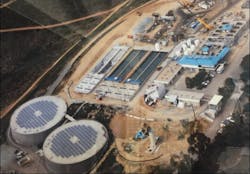Generating sodium hypochlorite on-site in South San Diego
SAN DIEGO, CA, FEB 28, 2020 -- Located in southern San Diego County, the Otay Water Treatment Plant, with a capacity of 34 million gallons per day (MGD), provides drinking water to an estimated 100,000 customers. The plant is operated by the City of San Diego and located less than two miles from the United States – Mexico border, north of Tijuana. Despite being 15 miles from the Pacific Ocean, the arid region is considered part of the Colorado Desert and receives an average of only ten inches of rain each year.
With virtually no local water sources available for use, the City of San Diego relies on water from the Metropolitan Water District, which imports its water from the Colorado River and the California State Water Project. The two massive water projects bring water from other watersheds and regions hundreds of miles to the north and east.
Constructed as a conventional treatment plant, the Otay Water Treatment Plant used chlorine dioxide produced from chlorine gas for disinfection as the incoming water was high in naturally occurring organic matter. While the use of chlorine gas provided a strong disinfectant for the treated water, operators with the City began to consider other disinfection options as the area surrounding Otay grew and expanded. Given the residential encroachment around the plant, the City wanted to find safer alternative sources of chlorine. Senior Water Operations Superintendent, Jim McVeigh was forward-leaning in seeking innovative technologies to provide safer, more sustainable water disinfection for the community.
The City’s multiple treatment plants in the region routinely stored between 20 and 40 tons of chlorine gas at each facility in one-ton pressurized cylinders. Each plant’s safety facilities were equipped to neutralize a maximum of one ton of released chlorine. This meant the risk of an uncontrolled release of tens of thousands of pounds of chlorine was possible, with a danger zone extending 20 miles downwind from a release site. Heightened concerns around terrorism over the past several decades have brought increased safety reporting and training requirements for water districts across the country. In California, the use of chlorine gas requires registration through the California Accidental Release Prevention (CalARP) program which includes a rigorous Risk Management Plan, as well as on-site safety audits. Storage of chlorine gas is also recognized by the Federal Department of Homeland Security as a potential terrorist target.
A net present value (NPV) analysis comparing trucked-in commercial strength sodium hypochlorite and installation of an on-site sodium hypochlorite generation (OSHG) system was conducted in order to evaluate the combined long-term capital and operating costs of the respective options. The analysis included risks and hazards associated with minor and catastrophic chlorine gas releases as cost factors. A major drawback to the use of bulk hypochlorite (approximately 12.5% concentration) was the anticipated frequency of truck deliveries through the community, which includes an
Olympic athlete training center near the treatment plant. The safety and reliability of the OSHG system was appealing from the standpoint of reducing the overall risk to the community, simplifying operations and reducing safety training requirements. In the end, the NPV calculation confirmed that OSHG was the most cost-effective solution based on overall risk reduction and capital and operating costs.
Once City officials decided on the Microclor® OSHG system, they worked with the engineers at PSI Water Technologies (PSI) in Campbell, California to design a system for the new treatment plant processes. The OSHG system was sized with redundancy to include two 1,000 pound-per-day chlorine generation skids. The design also included bulk hypochlorite dilution panels which aided in start-up, as well as providing further redundancy of disinfectant supply.
PSI provided project management support during the construction phase, as well as training, start-up, and commissioning of the new secondary disinfection system, which utilizes sodium hypochlorite generated on-site and liquid ammonium sulfate (delivered to the site) to create monochloramines. Since start-up, Otay Water Treatment Plant operators have observed numerous measurable advantages with the new system. The 0.8% sodium hypochlorite (bleach) produced by the Microclor® OSHG system is less reactive and more stable over time, versus highly concentrated bulk bleach. This steady source of consistent-quality sodium hypochlorite has improved control of the chlorination process, eliminated backwash chlorine spikes and reduced THM formation at the plant. In addition, the switch to OSHG means the City is no longer required to register with the CalARP program, saving hundreds of staff hours previously dedicated to compliance, reporting, training and audits.
Thanks to the Microclor® OSHG system, the City of San Diego’s Otay Water Treatment Plant now has a safe and reliable source of chemical disinfection that has simplified operations.
"We now have safer and more reliable disinfection and have eliminated our CalARP risk management program requirements,” Patrick Boyd, Senior Water Operations Supervisor, City of San Diego Water Department said.

